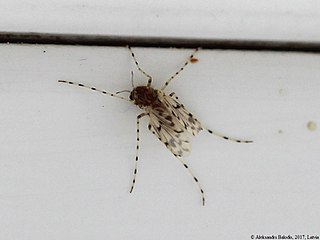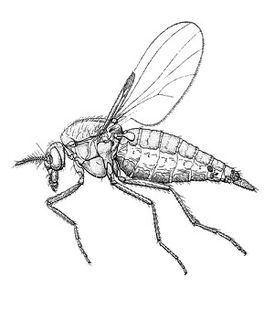
Ceratopogonidae is a family of flies commonly known as no-see-ums, or biting midges, generally 1–3 mm in length. The family includes more than 5,000 species, distributed worldwide, apart from the Antarctic and the Arctic.

The Chironomidae comprise a family of nematoceran flies with a global distribution. They are closely related to the Ceratopogonidae, Simuliidae, and Thaumaleidae. Many species superficially resemble mosquitoes, but they lack the wing scales and elongated mouthparts of the Culicidae. An example of mosquito-resembling species is Tokunagayusurika akamusi.

Orthocladiinae is a subfamily of midges in the non-biting midge family (Chironomidae). For lack of a better common name, they are simply referred to as orthoclads.
Jean-Jacques Kieffer was a French naturalist and entomologist who specialised in the study of parasitic insects. Educated as a priest, Kieffer taught natural science in Bitche, Lorraine while working on the description and classification of insects. His work and publications later became a predominant source of description and classification for entomologists in the early 20th century, in particular with regard to parasitoid wasps, midges, and mosquitos.

The Cecidomyiinae are a subfamily of flies often called gall midges or gall gnats. Many are parasitoids or predacious as maggots.

The Lasiopteridi is a supertribe of flies from the family Cecidomyiidae. They are often called gall midges or gall gnats.

Chironominae is a subfamily of midges in the non-biting midge family (Chironomidae).

Chironomini is a tribe of midges in the non-biting midge family (Chironomidae).

Glyptotendipes is a genus of non-biting midges in the subfamily Chironominae of the bloodworm family Chironomidae.
Paracladopelma is a genus of Palearctic and Nearctic non-biting midges in the subfamily Chironominae of the bloodworm family Chironomidae.

Tanytarsini is a tribe of midges in the non-biting midge family (Chironomidae).

Tanypodinae is a subfamily of midges in the non-biting midge family (Chironomidae). The larvae are generally carnivorous and their mouthparts are adapted for predation on small invertebrates although 1st and 2nd instar larvae also feed on algae.
Macropelopiini is a tribe of midges in the non-biting midge family (Chironomidae).
Telmatogetoninae is a subfamily of midges in the non-biting midge family (Chironomidae).

Telmatogeton is a genus of midges in the non-biting midge family (Chironomidae).

Leptoconops is a midge genus in the family Ceratopogonidae. It has a mostly tropical or subtropical distribution worldwide, but some species occur as far north as Moscow region in Russia and the Yukon Territory in Canada.

Contarinia is a genus of midges, small flies in the family Cecidomyiidae.
Cystiphora is a genus of gall midges in the family Cecidomyiidae. There are about seven described species in Cystiphora.
Nilobezzia is a genus of biting midges in the family Ceratopogonidae. There are more than 70 described species in Nilobezzia.

Winnertzia is a genus of gall midges and wood midges in the family Cecidomyiidae. There are more than 90 described species in Winnertzia.










